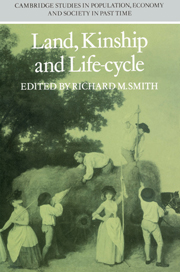Book contents
- Frontmatter
- Contents
- List of contributors
- Preface
- 1 Some issues concerning families and their property in rural England 1250–1800
- 2 Population pressure, inheritance and the land market in a fourteenth-century peasant community
- 3 Families and their land in an area of partible inheritance: Redgrave, Suffolk 1260–1320
- 4 Population changes and the transfer of customary land on a Cambridgeshire manor in the fourteenth century
- 5 Industrial employment and the rural land market 1380– 1520
- 6 Changes in the size of peasant holdings in some west midland villages 1400–1540
- 7 The erosion of the family–land bond in the late fourteenth and fifteenth centuries: a methodological note
- 8 Changes in the link between families and land in the west midlands in the fourteenth and fifteenth centuries
- 9 Kinship in an English village: Terling, Essex 1550–1700
- 10 The myth of the peasantry: family and economy in a northern parish
- 11 Poverty, poor relief and the life-cycle: some evidence from seventeenth-century Norfolk
- 12 The receipt of poor relief and family situation: Aldenham, Hertfordshire 1630–90
- 13 Widows in pre-industrial society: an essay upon their economic functions
- 14 Real property, marriage and children: the evidence from four pre-industrial communities
- 15 The nineteenth-century peasantry of Melbourn, Cambridgeshire
- Consolidated Bibliography
- Index
8 - Changes in the link between families and land in the west midlands in the fourteenth and fifteenth centuries
Published online by Cambridge University Press: 19 October 2009
- Frontmatter
- Contents
- List of contributors
- Preface
- 1 Some issues concerning families and their property in rural England 1250–1800
- 2 Population pressure, inheritance and the land market in a fourteenth-century peasant community
- 3 Families and their land in an area of partible inheritance: Redgrave, Suffolk 1260–1320
- 4 Population changes and the transfer of customary land on a Cambridgeshire manor in the fourteenth century
- 5 Industrial employment and the rural land market 1380– 1520
- 6 Changes in the size of peasant holdings in some west midland villages 1400–1540
- 7 The erosion of the family–land bond in the late fourteenth and fifteenth centuries: a methodological note
- 8 Changes in the link between families and land in the west midlands in the fourteenth and fifteenth centuries
- 9 Kinship in an English village: Terling, Essex 1550–1700
- 10 The myth of the peasantry: family and economy in a northern parish
- 11 Poverty, poor relief and the life-cycle: some evidence from seventeenth-century Norfolk
- 12 The receipt of poor relief and family situation: Aldenham, Hertfordshire 1630–90
- 13 Widows in pre-industrial society: an essay upon their economic functions
- 14 Real property, marriage and children: the evidence from four pre-industrial communities
- 15 The nineteenth-century peasantry of Melbourn, Cambridgeshire
- Consolidated Bibliography
- Index
Summary
Dr Razi has done us a great service by applying his detailed researches into the manorial court rolls of Halesowen to the problem of inheritance in the late fourteenth and early fifteenth centuries. He has shown that the use of surnames alone to indicate the existence of blood relationships provides an inadequate guide to the transfer of land within the family, and that the use of sensitive research methods shows that remote relatives, many of them living at some distance from Halesowen, claimed holdings when they became available. However, it is important to recognize Halesowen's special characteristics, and if we examine the records of a wider range of manors in the west midlands we can see that the generalizations of Faith, Harvey or Hilton about the changes in the link between peasant families and land still have some validity.
At the centre of Halesowen lay a small urban community which must have exercised a considerable influence over the surrounding countryside. Halesowen borough lay in the centre of a knot of boroughs, eight of them within a radius of ten miles. Through this relatively urbanized district ran long-distance trade routes, notably the droving roads that brought large numbers of Welsh cattle into the midlands and ultimately to London; here also were short-distance routes for the local trade in foodstuffs and iron and leather goods. Rural and small-town industries had developed in the district by the thirteenth century, and seem to have flourished in the later middle ages. The agricultural economy was less dependent on cereal cultivation than that of the older-settled or more densely populated champion districts of the midlands.
- Type
- Chapter
- Information
- Land, Kinship and Life-Cycle , pp. 305 - 312Publisher: Cambridge University PressPrint publication year: 1985

